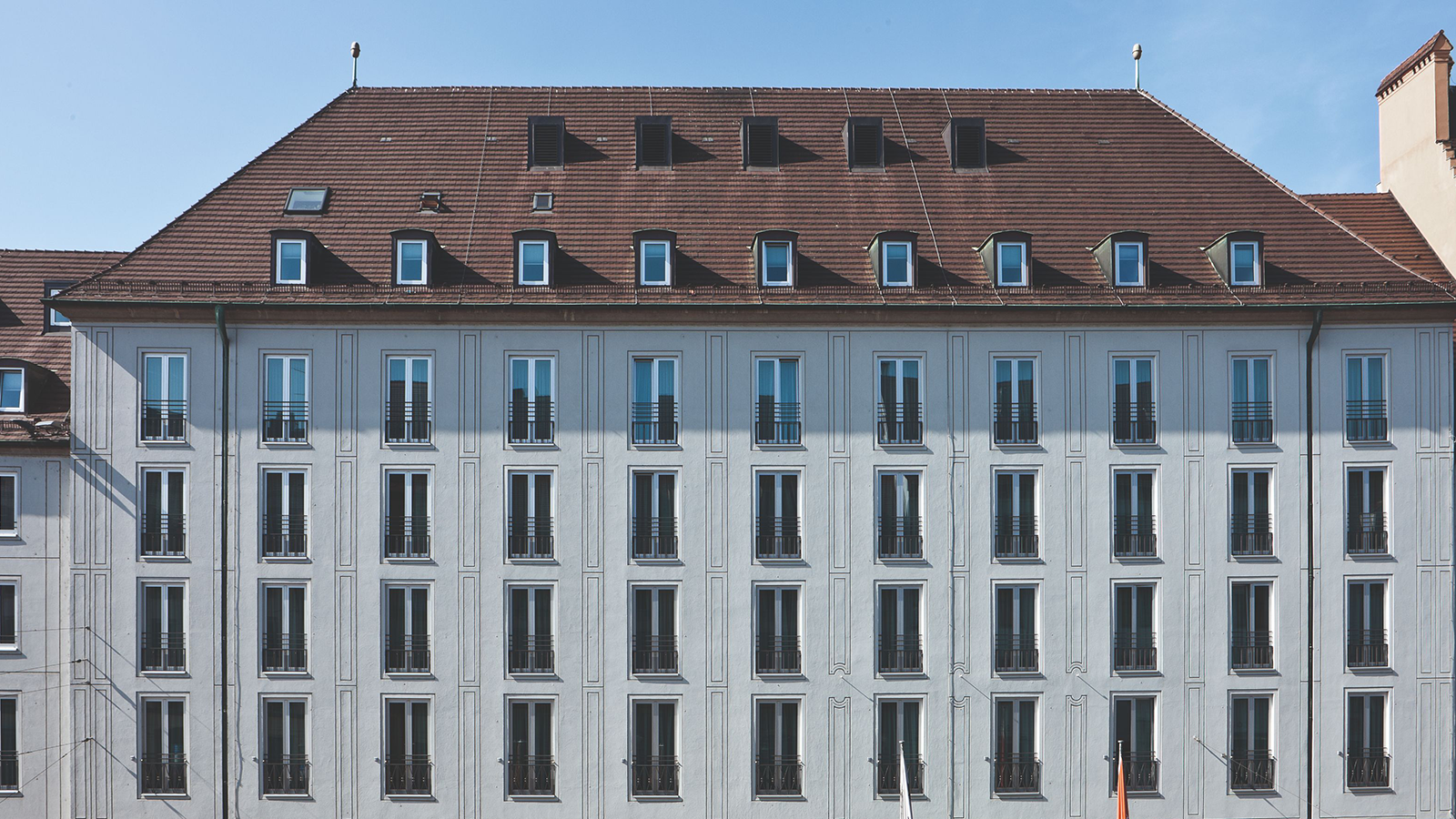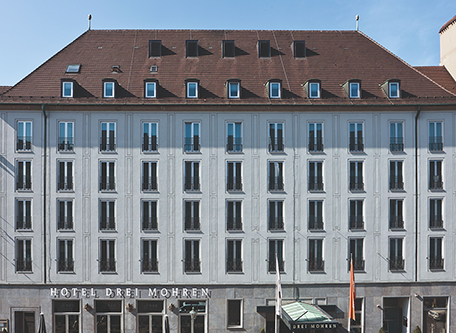Receive for Free - Discover & Explore eNewsletter monthly with advance notice of special offers, packages, and insider savings from 10% - 30% off Best Available Rates at selected hotels.
history
Discover Hotel Maximilian’s, which has hosted the likes of Napoleon Bonaparte, Wolfgang Amadeus Mozart, and Johann Wolfgang von Goethe.
Hotel Maximilian’s, a Member of Historic Hotels Worldwide in 2019, dates back to 1722.
VIEW TIMELINE
A partner of Historic Hotels Worldwide since 2019, Hotel Maximilian’s is one of Augsburg’s most celebrated landmarks. While the historical record of Hotel Maximilian’s dates back to the 15th century, the current iteration of the building was constructed in the early 1700s. A local landlord named Andreas Wahl acquired the site along Augsburg’s Maximilianstraße, which was then occupied by an aging estate. Hiring noted architect Johann Baptist Gunezrhainer, Wahl subsequently converted the entire space into a brilliant guesthouse. The court mason for the Duchy of Bavaria, Gunezrhainer masterfully recrafted the hotel’s appearance in the regal style of Rococo architecture. Meanwhile, Wahl filled his new structure with some of the finest décor that one could find in Europe at the time. Wahl’s gorgeous guesthouse quickly grew in popularity across the continent, attracting all kinds of aristocrats and intellectuals. A guestbook recently located in the attic of the hotel even revealed over 500 pages of historical signatures from those prominent guests. Over the course of the century, the likes of Giacomo Casanova, Wolfgang Amadeus Mozart, and Johann Wolfgang von Goethe had all spent time at the guesthouse. Even some of Europe’s most powerful figures—such as King Friedrich Wilhelm I of Prussia and Emperor Francis II of the Holy Roman Empire—had stayed inside the inn at one point or another. As such, the guesthouse eventually acquired the moniker as the “Prince Hostel.” Its appeal among European nobility remained strong well into the following century, too, as the likes of King Ludwig I of Bavaria, Czar Nicolas I of Russia, and Napoleon Bonaparte all visited the magnificent structure.
Wahl’s descendants managed the guesthouse until 1804, when they subsequently sold it to a hotelier named Johann Georg Deuringer. Deuringer and his son operated the facility throughout the Napoleonic Wars, slowly transitioning the guesthouse into a more “conventional” hotel. The family even instituted a massive renovation that saw the building’s whole layout change dramatically. But despite their masterful stewardship over the inn, the Deuringers decided to sell the business to a stock company in the 1870s. A period of fluid ownership that saw Augsburg city councilor Ludwig Leybold briefly operate the facility, a hospitality company decided to obtain the site in 1929. It continued to remain under the control of the company, even as the Great Depression and World War II periodically strained the German economy. In fact, the hotel was the victim of a bombing raid by an Allied air strike in February 1944. It took a few years for the hospitality company to repair the historic hotel, beginning the reconstruction efforts once the war had ended. Taking several years to complete, the company finally reopened the brilliant destination with a grand gala in 1956. Within a matter of months, the hotel was soon back to alluring all kinds of guests from throughout the continent, making it Augsburg’s leading holiday retreat once more. Then in 1979, the hotel transferred the business over to Steigenberger Hotel AG, which operated the location for the next 41 years! Now known as "Hotel Maximilian's," this wonderful historic hotel possesses a wealth of history that guests will certainly enjoy.
-
About the Location +
Located in the Bavarian region of Swabia, Augsburg is among Germany’s most historic cities. In fact, the locale dates all the way back to the Roman Empire, when brothers Nero Claudius Drusus and Tiberius Caesar Augustus founded it as “Augusta Vindelicorum” in the 1st century BC. Both Drusus and Tiberius had created the community under the orders of their stepfather, Emperor Augustus. (Tiberius himself would later succeed his father as Rome’s second emperor.) The Romans had specifically selected the spot to serve as a military camp due to its access to both the Lech and Wertach rivers, as well as several mountain passes that cut through the Alps. Augsburg quickly became a major supply depot for the Roman legionnaires who were tasked with traveling further into the German interior. Its importance proved to be so great that the Romans eventually elevated the city as the capital for the Province of Raetia. And while Augsburg continued to function as a strategic military facility for the Roman Empire, it gradually evolved into an actual city over the next 400 years. By the time the civilization collapsed in the 5th century, Augsburg had emerged as one of Europe’s most significant centers of trade and commerce. And by the time of Charlemagne’s rule some three centuries later, Augsburg had risen to become one of Central Europe’s most prosperous settlements.
During the Middle Ages, much of the area known as Germany today fell under the jurisdiction of a multiethnic complex of principalities, bishoprics, and kingdoms called the Holy Roman Empire. Considered by some to be a successor of Rome, the “empire” first came into existence in the 10th century. Yet, imperial authority remained constrained, allowing for the disparate aristocrats to govern their own territories with relative autonomy. Over time, this system gave way to a limited elective monarchy, in which the emperor was chosen from a select group of prince-electors. At first, Augsburg operated as part of a local prince-bishopric within the Holy Roman Empire, separating from to polity to become a “Free Imperial City” in 1276. It remained a “Free Imperial City” for the next several centuries, although influence from the nearby prince-bishopric flared tensions from time to time. Nevertheless, Augsburg continued to dominate the regional economy, especially as banks and textile manufactories emerged within the city. This development was spurred on by two families in particular, the Fuggers and the Welsers. Both families greatly influenced local politics, playing a significant role in the city’s administration. In fact, the Fuggers donated a social housing complex known as the “Fuggerei” to Augsburg, which is still in use today!
Augsburg enjoyed relative peace, especially after Emperor Charles V signed the Treaty of Augsburg in 1855. It subsequently granted protections to religious minorities in the wake of the Protestant Reformation. Yet, this harmony gradually waned as Catholics and Protestants became belligerent toward one another amid The Wars of Religion in the 17th century. The most violent outburst occurred during the Thirty Years War, often regarded by historians as one of the most destructive conflicts in Europe’s history. The war itself started when Emperor Ferdinand II tried to reverse the Peace of Augsburg in the name of Catholic hegemony, inciting a religious civil war that eventually involved nearly every major European power at the time. During the conflict, a Swedish army fighting for the Protestants marched on Augsburg, capturing the city without resistance. But in 1634, the Swedes were routed by Catholic forces at the Battle of Nördlingen. The Catholic troops then besieged Augsburg, killing thousands in the process. Augsburg began to recover somewhat in the aftermath of the Thirty Years’ War, only to enter into another conflict called the “Nine Years’ War” in 1686. Its citizens joined the fight to protect the Palatinate—another member of the Holy Roman Empire—form the imperial machinations of France. Fortunately, the city itself remained relatively unscathed.
Augsburg’s status as a Free Imperial City came to an end during the Napoleonic Wars, when the armies of Napoleon Bonaparte destroyed the Holy Roman Empire. In its place, Augsburg joined the larger Kingdom of Bavaria, eventually becoming the capital for the administrative regions of Swabia and Neuburg. Nevertheless, Augsburg continued to be a vibrant economic hub, even as the Industrial Revolution spread throughout the city after the first unification of Germany in 1871. Textile manufacturing remained incredibly strong, as well as a new factories that created all sorts of specialized machine parts. Its economic importance persisted well into the 20th century, even as war could gathered once more over the continent. Augsburg’s prominence as a manufacturing center eventually made it the target of continuous Allied air raids during World War II, culminating with a massive nighttime bombing strike in February of 1944. The local residents tirelessly rebuilt Augsburg following the end of the conflict, where it remained a part of West Germany until 1990. Augsburg today is one of Germany’s most vibrant cities, filled with all kinds of exciting cultural attractions to experience.
-
About the Architecture +
When architect Johann Baptist Gunezrhainer first designed the façade of Hotel Maximilian’s, he decided to use the opulent style of Rococo architecture for his inspiration. Also called “Late Baroque,” Rococo architecture first arose in popularity across Europe during the first-half of the 18th century. It specifically appeared in pre-Revolutionary France as a reaction to the ponderous and overwhelming classicism of King Louis XIV’s brand of architecture, best epitomized by his famous Palace of Versailles. Instead, several painters, engravers, and architects created their own equally impressive artistic style that sought to institute a more charming and intimate aesthetic into society. At first, Rococo appeared at the private residences of affluent French merchants and middling aristocrats, before it quickly spread to other areas in Europe. Southern Germany itself was one of the major areas where Rococo became incredibly popular, with most of the work concentrated in Augsburg. Many also saw it as a secular challenge to the supremacy of monarchical power, as the architectural style was primarily embraced by the emerging middle classes of Europe. Rococo borrowed heavily from the preexisting rocaille style and blended it with the ornate details of Italian Baroque. The new architectural form made wide use of elaborate, asymmetrical scrolling curves, designed in a way that typically mimicked either a “C” or an “S” shape. Other curvaceous figures included shells and rocks, so as to give a natural feel to the architecture. Entire rooms were also completely circular or elliptical in their layout, providing a sense of constant motion and drama within the space. Architects also relied upon a hue of pastel colors that instituted a combination of light and brightness to every room. Gold, too, appeared occasionally, but not to the extent that it had amid King Louis’ reign. It was used with purpose, employed to convey a sense of awe, but not bewilderment. Grand pieces of artwork defined the interior, too, as did a wealth of sculpted molding and decorative gilding. Perhaps the single greatest type of art utilized was the trompe l’oeil. The trompe l’oeil was a fresco that used realistic imagery to create an optical illusion that made the depicted objects appear as if they were three dimensional.
-
Famous Historic Guests +
Giacomo Casanova, author of the Histoire de ma vie (Story of My Life).
Wolfgang Amadeus Mozart, composer known for the likes of The Marriage of Figaro and Requiem Mass in D Minor.
Johann Wolfgang von Goethe, author known for writing Faust and The Sorrows of Young Werther.
Friedrich Wilhelm I. von Preußen, King of Prussia (1713 – 1740)
Duchess Maria Luisa Charlotte Infanta of Spain and Holy Roman Empress (1790 – 1792)
King Francis II, Holy Roman Emperor (1792 – 1806) and Emperor of Austria (1804 – 1835)
Napoleon Bonaparte I, Emperor of the French (1804 – 1814; 1815)
King Maximillian I Joseph of Bavaria (1806 – 1825)
King Otto I of Greece (1823 – 1862)
Czar Nicholas I of Russia (1825 – 1855)
King Ludwig I of Bavaria (1825 – 1848)
Queen Therese of Bavaria (1825 – 1848)


























